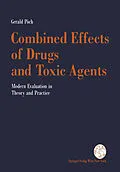1 Principle considerations of drug actions and interactions.- 1.1 Introduction.- 1.2 Dose-response curves.- 1.2.1 The parameters of dose-response curves.- 1.2.2 Models and curve-fitting.- 1.2.3 Comparison of curves.- 1.3 Time course of effects.- 1.4 Phenomena and mechanisms: interactions between drugs - antagonism and synergism.- 1.4.1 Simple interactions.- 1.4.2 Complex interactions.- Phenomena.- Mechanisms of interaction.- 2 Concepts and models of interactions - additivity and independence.- 2.1 Concept and phenomenon of additivity.- 2.1.1 Historical perspective.- 2.1.2 The isobologram.- 2.1.3 Dose-response curves.- 2.1.4 Mechanism underlying additivity.- 2.1.5 Additive dose-response curves.- 2.1.6 Comparison of effect-additive with dose-additive combinations.- 2.2 Site-directed analysis.- 2.3 Concept of independence.- 2.3.1 Calculation of independent effects.- 2.3.2 Independent dose-response curves.- 2.4 Relationship between additivity and independence.- 2.4.1 Dose-additive and independent combinations.- 2.4.2 Effect-additive and independent combinations.- 2.5 Summary and conclusions.- 2.6 Tips and hints.- 3 Synergism/potentiation and antagonism - phenomena and mechanisms.- 3.1 The current dilemma.- 3.1.1 The "effect approach".- 3.1.2 The "dose approach" (evaluation of isobolograms).- 3.2 Towards a uniform characterization of synergism/potentiation and antagonism.- 3.3 Potentiation (synergism).- 3.3.1 Net effects.- 3.3.2 Total effects.- 3.4 Antagonism.- 3.4.1 The "effect approach".- 3.4.2 The "dose approach" (evaluation of isobolograms).- 3.5 Comparison of complex with simple interactions.- 3.6 Quantitative expression of combined effects.- 3.6.1 The combination index (CI).- 3.6.2 Comparison of CI and combined-effect graph.- 3.7 Suggestions for quantitation of combined effects.- 3.8 Tips and hints.- 4 Evaluation by dose-response curves.- 4.1 New methodological approach: fixed-dose studies.- 4.1.1 Construction of experimental and theoretical dose-response curves.- 4.1.2 Statistical comparison of observed and expected response 58 Chi-square goodness-of-fit test 58 . F-test.- 4.1.3 Expression of results and examples.- 4.2 Fixed dose-ratio combinations.- 4.2.1 Dose-additive interactions.- 4.2.2 Independent actions.- 4.2.3 Multiple combinations.- 4.3 Tips and hints.- 5 Evaluation by time-course studies.- 5.1 Time course of independent actions.- 5.2 Dose-additive time course.- 5.3 Statistical comparison of observed and expected time course.- 5.4 Time-course studies with log response scale.- 5.5 Comparison of time-course studies and dose-response studies.- 5.6 Conclusions.- 6 Single-dose and other studies.- 6.1 Single-dose studies.- 6.1.1 Comparison with effect-additive.- 6.1.2 Comparison with independence.- 6.1.3 Comparison with additivity.- 6.1.4 Tips and hints.- 6.2 Other studies.- 7 Combined-effect graph and other graphs.- 7.1 The construction of the combined-effect graph.- 7.1.1 Percent of maximum response.- 7.1.2 Percent of control response.- 7.2 Comparison of observed with independent effects.- 7.3 Yonetani-Theorell plot for enzyme inhibitors.- 7.4 Tips and hints.- 8 Applications of the new approach and observations.- 8.1 Biochemistry and physiology/pathophysiology.- 8.1.1 Dual inhibition of enzyme activity.- 8.1.2 Physiology.- 8.1.3 Pathophysiology.- 8.2 Experimental pharmacology.- 8.2.1 Dose-response studies: site of action.- 8.2.2 Extent of enhancement.- 8.2.3 "Unspecifically" acting agents in combination.- 8.3 Clinical pharmacology - drug combinations.- 8.3.1 Dose-response studies.- 8.3.2 Drug mixtures: dose-response studies.- 8.3.3 Drug mixtures: time-course studies.- 8.3.4 Single-dose studies.- 8.4 Chemotherapy of infections and tumors.- 8.4.1 Therapy of infections.- 8.4.2 Tumortherapy.- 8.5 Experimental and environmental toxicology.- 8.5.1 Examples of toxic interactions.- 8.6 Epidemiology - risks.- 8.7 Herbicides.- 8.8 Conclusions and discussion.- 8.8.1 Methods.- 8.8.2 Comparison with model interactions.- 9 A new and critical view of isobolograms.- 9.1 Inappropriate conclusions.- 9.2 Pitfalls.- 10 Comparison of the new with the conventional approach.- 10.1 Experimental dose-response curves and isobolograms.- 10.1.1 Concurring interpretation.- 10.1.2 Different and controversial interpretation.- Envelope of additivity in isobolograms.- Nonconsideration and incorrect calculation of independence.- 10.2 Evaluation of combined effects in the future.- Epilog.- Appendix A - Glossary of terms and abbreviations.- Appendix B - Guide to practical work: exercise examples.- References.
